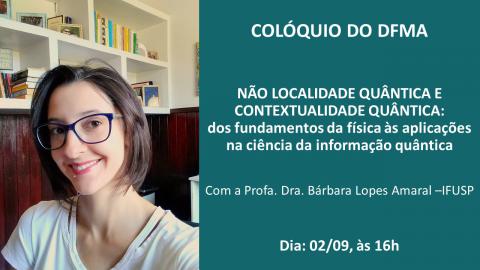Simetrias e Assimetrias em Física



*Transmissão via zoom e youtube*
Resumo: Uma revolução industrial começa com uma nova tecnologia, que embora útil não é muito bem entendida. Isto estimula a explorar variações das máquinas, determinar seus limites e, numa terceira fase, talvez à descoberta de extensões teóricas e práticas inimagináveis no começo. As Redes Neurais (RN) ocupam o lugar das máquinas a vapor no século 18. É difícil falar das mudanças que este processo trará para a sociedade e portanto vou falar um pouco das duas primeiras fases. Neste colóquio falarei sobre tentativas de entendimento de algumas das diferentes dinâmicas que podem ser estudadas em RN. A RN funciona mapeando uma representação do problema a ser considerado a uma representação diferente que é aproximadamente a resposta desejada. Estudos da dinâmica de aprendizagem lidam com a incorporação de informação a partir de dados. Algoritmos de aprendizagem levam a que uma RN possa resolver certos problemas apresentando capacidade de memorização, ou seja de dar uma resposta razoável em casos já vistos no treinamento. Mais importante, se a quantidade de dados for maior que um certo valor (dimensão VC da RN) não é mais possível memorizar exceto se houver uma regra, então a rede também será capaz de generalizar: prever o resultado para novas situações. Em certos casos é possível obter o algoritmo que leva à máxima generalização possível. Aplicações que mostram resultados surpreendentes nos deixam perplexos pois muitas vezes uma máquina pode obter resultados que ultrapassam o desempenho humano mas não indicam os mecanismos subjacentes. A segunda dinâmica descreve como muda a representação de uma questão à medida que é processada pela rede. Esta dinâmica pode ser descrita em termos de generalizações do Grupo de Renormalização. Finalmente falarei um pouco de sistemas de RN interagentes que podem ser usadas para modelar certos aspectos de sociedades.


Transmissão via zoom e YouTube
Resumo: A presença de bipolarons em cupratos supercondutores é um fato experimental conhecido já há algumas décadas. Porém, o exato papel destes no fenômeno da supercondutividade ainda não é bem compreendido. Propomos e analisamos um modelo para estruturas microscópicas específicas destes materiais, que inclui modos bipolarônicos. As diversas constantes de acoplamento deste foram escolhidas de acordo com resultados experimentais recentes sobre cupratos. No setor de um bipolaron e dois férmions (buracos), o modelo foi capaz de explicar a formação de pares (de buracos) de tipo “d-wave” com massa efetiva muito inferior à dos bipolarons, a temperatura de “pseudo-gap” (temperatura abaixo da qual os pares se formam, muito superior à temperatura de transição à fase supercondutora) com boa precisão, assim como o comprimento de coerência (diâmetro típico dos pares), observados em cupratos. Referência: Isotropic Bipolaron-Fermion-Exchange Theory and Unconventional Pairing in Cuprate Superconductors, J.-B. Bru, A. de Pasquale e WdSP. Annalen der Physik, 2019.


Resumo: The 2010s have been marked by two fundamental discoveries: the detection of the Higgs boson in 2012 and the first direct detection of Gravitational Waves in 2015. On one hand, the discovery of the Higgs boson has exacerbated the so-called Hierarchy problem (i.e. the mystery of why the Higgs boson mass is so light); on the other hand, the detection of gravitational waves has opened up the possibility of probing the physics of the early universe in previously unaccessible regimes. Interestingly, these regimes can host physics related to the hierarchy problem. In the first part of the talk, I will review the physics of gravitational waves and the hierarchy problem. I will then explain possible connections between the two, and how gravitational waves can be studied to get informations about the hierarchy problem.
Transmissão com acesso livre via plataforma zoom (https://zoom.us/j/996276017).


Além do importante papel da não localidade e da contextualidade nos fundamentos da teoria quântica, essas propriedades intrinsecamente quânticas foram identificadas como recursos para vantagem em diferentes tarefas. Portanto, é de fundamental importância estudá-las do ponto de vista das teorias de recursos, que fornecem uma estrutura poderosa para o tratamento formal de uma propriedade como um recurso operacional. Nesta contribuição, revisamos os desenvolvimentos recentes em direção a uma teoria de recursos unificada de não localidade e contextualidade e conexões com aplicações operacionais dessas propriedades.
Transmissão com acesso livre via plataforma zoom (https://zoom.us/j/996276017)

Este seminário apresenta os esforços do Observatório COVID-19 BR durante a atual pandemia. Aborda-se a questão de quais dados usar na descrição da epidemia, seu tratamento estatístico e a construção de modelos matemáticos para criar cenários futuros. Discute-se, ao fim, como o poder público usa dados e análises nas tomadas de decisões.
Transmissão com acesso livre via plataforma zoom (https://zoom.us/j/996276017)